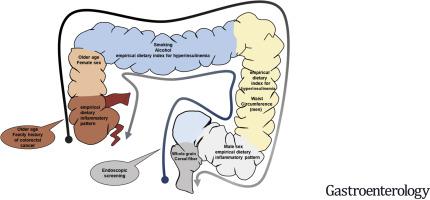Gastroenterology ( IF 25.7 ) Pub Date : 2020-04-01 , DOI: 10.1053/j.gastro.2020.03.054 Liang Wang 1 , Chun-Han Lo 2 , Xiaosheng He 3 , Dong Hang 4 , Molin Wang 5 , Kana Wu 6 , Andrew T Chan 7 , Shuji Ogino 8 , Edward L Giovannucci 9 , Mingyang Song 10

|
Background & Aims
The molecular features of colorectal tumors differ with their anatomic location. Colorectal tumors are usually classified as proximal or distal. We collected data from 3 cohorts to identify demographic, clinical, anthropometric, lifestyle, and dietary risk factors for colorectal cancer (CRC) at 7 anatomic subsites. We examined whether the associations differ among refined subsites and whether there are trends in associations from cecum to rectum.
Methods
We collected data from the Nurses’ Health Study, Nurses’ Health Study 2, and Health Professionals Follow-up Study (45,351 men and 178,016 women, followed for a median 23 years) on 24 risk factors in relation to risk of cancer in cecum, ascending colon, transverse colon, descending colon, sigmoid colon, rectosigmoid junction, and rectum. Hazard ratios were estimated using Cox proportional hazards regression. We tested for linear and nonlinear trends in associations with CRC among subsites and within proximal colon, distal colon, and rectum.
Results
We documented 3058 cases of CRC (474 in cecum, 633 in ascending colon, 250 in transverse colon, 221 in descending colon, 750 in sigmoid colon, 202 in rectosigmoid junction, and 528 in rectum). The positive associations with cancer risk decreased, from cecum to rectum, for age and family history of CRC. In contrast, the inverse associations with cancer risk increased, from cecum to rectum, for endoscopic screening and intake of whole grains, cereal fiber, and processed red meat. There was a significant nonlinear trend in the association between CRC and female sex, with hazard ratios ranging from 1.73 for ascending colon cancer to 0.54 for sigmoid colon cancer. For proximal colon cancers, the association with alcohol consumption and smoking before age 30 years increased from the cecum to transverse colon. For distal colon cancers, the positive association with waist circumference in men was greater for descending vs sigmoid colon cancer.
Conclusions
In an analysis of 3058 cases of CRC, we found that risk factor profiles differed for cancers along the colorectum. Proximal vs distal classifications are not sufficient to encompass the regional variations in colorectal tumor features and risk factors.
中文翻译:

结直肠不同区域的癌症的危险因素有所不同。
背景与目标
结直肠肿瘤的分子特征因其解剖位置而异。结直肠肿瘤通常分为近端或远端。我们收集了 3 个队列的数据,以确定 7 个解剖亚位点的人口统计学、临床、人体测量、生活方式和饮食风险因素。我们检查了细化亚位点之间的关联是否存在差异,以及从盲肠到直肠的关联是否存在趋势。
方法
我们从护士健康研究、护士健康研究 2 和健康专业人员随访研究(45,351 名男性和 178,016 名女性,中位随访时间为 23 年)中收集了与盲肠癌症风险相关的 24 个风险因素的数据,升结肠、横结肠、降结肠、乙状结肠、直肠乙状结肠交界处和直肠。使用 Cox 比例风险回归估计风险比。我们测试了亚位点之间以及近端结肠、远端结肠和直肠内与 CRC 关联的线性和非线性趋势。
结果
我们记录了 3058 例 CRC 病例(盲肠 474 例,升结肠 633 例,横结肠 250 例,降结肠 221 例,乙状结肠 750 例,直肠乙状结肠交界处 202 例,直肠 528 例)。从盲肠到直肠,年龄和结直肠癌家族史与癌症风险的正相关性降低。相比之下,从盲肠到直肠,内窥镜筛查和全谷物、谷物纤维和加工红肉的摄入量与癌症风险的负相关性增加。 CRC 与女性之间的关联存在显着的非线性趋势,风险比范围为升结肠癌的 1.73 到乙状结肠癌的 0.54。对于近端结肠癌,30 岁之前饮酒和吸烟的相关性从盲肠到横结肠逐渐增加。对于远端结肠癌,降结肠癌与乙状结肠癌与男性腰围的正相关性更大。
结论
在对 3058 例 CRC 病例的分析中,我们发现结直肠癌的危险因素分布各不相同。近端与远端分类不足以涵盖结直肠肿瘤特征和危险因素的区域差异。











































 京公网安备 11010802027423号
京公网安备 11010802027423号